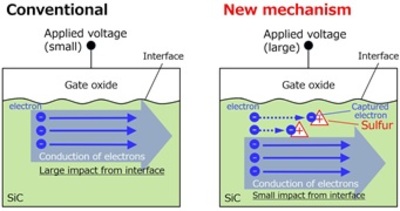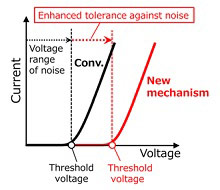- News
4 December 2018
Mitsubishi Electric and University of Tokyo reveal new mechanism for enhancing reliability of SiC power semiconductors
At the IEEE’s 64th International Electron Devices Meeting (IEDM 2018) in San Francisco, CA, USA (1-5 December), Tokyo-based Mitsubishi Electric Corp and the University of Tokyo have announced what they believe to be an all-new mechanism for enhancing the reliability of silicon carbide (SiC) power semiconductor devices in power electronics systems. The new mechanism was realized as a result of confirming that sulphur beneath the interface between the gate oxide and SiC captures some of the electrons conducting in the device’s current path, increasing the threshold voltage without changing the device’s on-resistance. The mechanism is expected to lead to more reliable power electronics equipment offering superior tolerance to electro-magnetic noise, which is known to cause system malfunctions.

Figure 1. Effects of sulphur beneath the gate oxide/SiC interface.
In their research, Mitsubishi Electric handled the design and fabrication of the SiC power semiconductor devices and analysis of sulphur’s capture of electrons in the current path, while the University of Tokyo handled the measurement of electron scattering.
Until now, it had been assumed that - compared to conventional nitrogen or phosphorus - sulphur is not a suitable element to supply electrons for current conduction in SiC power semiconductor devices. However, Mitsubishi Electric and the University of Tokyo focused on a different property of sulphur, namely that sulphur in SiC inherently tends to capture electrons. Confirmation of this property was the basis of developing the new mechanism for SiC power semiconductor devices.
 Picture: Relationship between SiC power semiconductor device’s current and voltage.
Picture: Relationship between SiC power semiconductor device’s current and voltage.
In the new mechanism, an appropriate quantity and distribution of sulphur in the SiC blocks electrons near the interface to a certain extent and hence increases the threshold voltage without impacting on-resistance. A suitable atom offering such an electrical property has been strongly sought to realize devices that are not prone to malfunctioning due to the effects of external electro-magnetic noise. The new mechanism is more reliable in this regard than conventional mechanisms and still retains low on-resistance.
Mitsubishi Electric says that, going forward, it aims to continue refining the design and specifications of its SiC metal-oxide-semiconductor field-effect transistor (SiC MOSFET) to further enhance the reliability of SiC power semiconductor devices.
Mitsubishi Electric SiC power MOSFET
www.MitsubishiElectric.com/semiconductors


